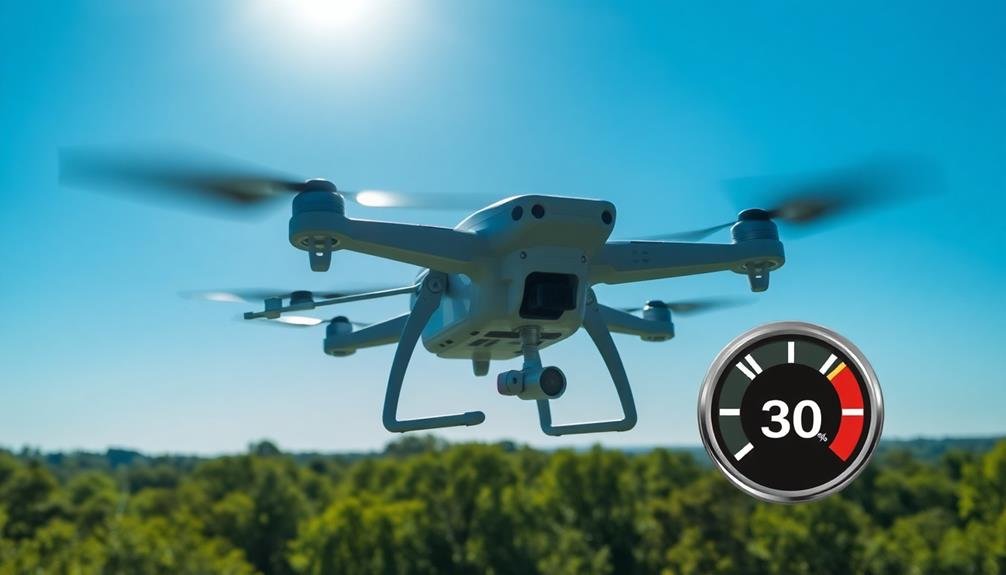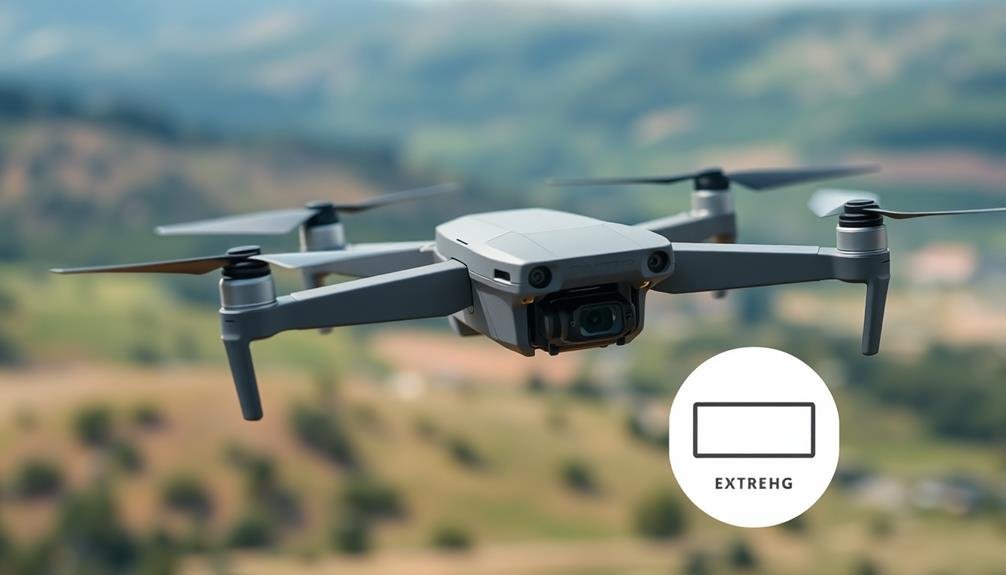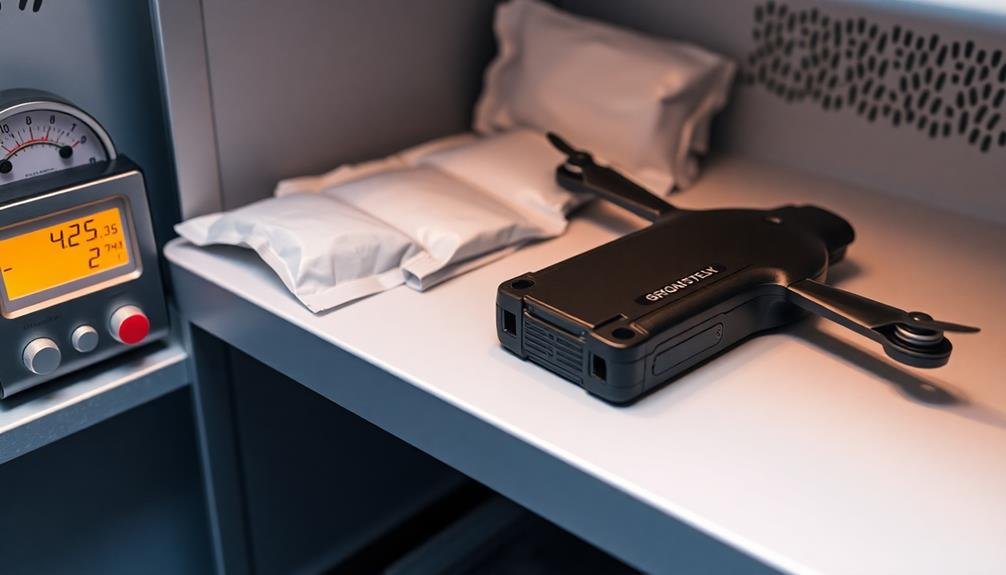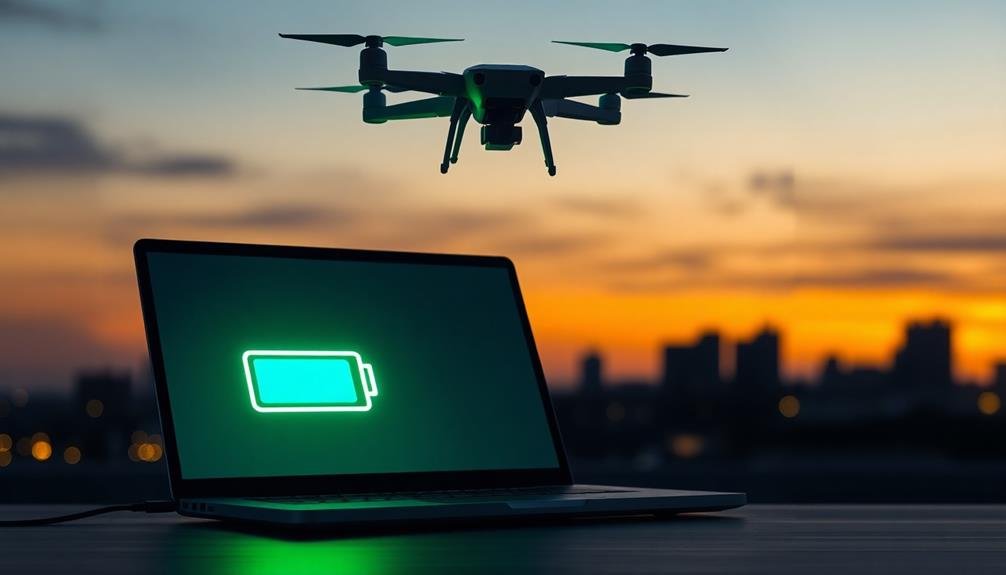To extend your drone's battery life, enhance flight settings by reducing speed and adjusting camera settings. Minimize payload weight by removing unnecessary accessories. Fly in moderate temperatures and calm weather conditions. Use propeller guards sparingly to improve aerodynamics. Store batteries properly and perform regular firmware updates. Utilize the return-to-home feature wisely and set ideal altitudes. Master efficient flight patterns to avoid wasting energy. Invest in high-quality batteries and monitor their health regularly. By implementing these strategies, you'll greatly increase your drone's flight time and overall performance. Dive deeper to access even more power-saving secrets for your aerial adventures.
Key Takeaways
- Optimize flight settings by reducing speed, adjusting camera settings, and enabling power-saving modes.
- Reduce payload weight by removing unnecessary accessories and using lighter components when possible.
- Fly in moderate temperatures and calm weather conditions to minimize battery drain.
- Perform regular firmware updates to ensure optimal power consumption and battery management.
- Invest in high-quality batteries from reputable manufacturers and monitor battery health regularly.
Optimize Flight Settings

One of the most effective ways to extend your drone's battery life is by optimizing its flight settings.
Start by reducing your drone's speed when possible. Flying at a slower pace consumes less power, allowing you to stay airborne longer.
Next, adjust the camera settings to conserve energy. Lower the resolution or frame rate if you don't need the highest quality footage for every flight.
Enable any power-saving modes your drone offers. These often limit certain functions but can greatly increase flight time.
Minimize the use of features like obstacle avoidance when flying in open areas. While useful, these systems drain the battery quickly.
Pay attention to wind conditions and plan your flight path accordingly. Flying against strong winds forces your drone to work harder, depleting the battery faster.
Instead, use tailwinds to your advantage when possible. Avoid unnecessary maneuvers and sudden changes in direction or altitude, as these actions consume more power.
Lastly, calibrate your drone's compass and IMU regularly. Proper calibration guarantees your drone flies efficiently, reducing unnecessary power consumption caused by overcompensation or erratic movements.
Reduce Payload Weight

How much weight is your drone carrying? Every gram matters when it comes to battery life. The heavier your drone, the harder its motors must work to keep it airborne, draining the battery faster.
To maximize flight time, strip your drone down to its essentials. Start by removing any unnecessary accessories. Take off add-ons like prop guards, landing gear, or camera gimbals if you're not using them for your current flight.
If your drone has a modular design, consider swapping out heavier components for lighter alternatives. For instance, use a smaller camera or a lighter battery if it meets your flight requirements.
Don't forget about the little things. Even small weights add up. Remove any decorative stickers or non-essential screws.
If you're carrying a payload, evaluate if you can use lighter materials or reduce the load. For mapping or surveying missions, opt for a lighter sensor if possible.
Fly in Ideal Weather Conditions

When flying your drone, keep in mind that weather conditions notably impact battery life.
You'll notice better performance in moderate temperatures, as extreme heat or cold can reduce battery efficiency.
Additionally, strong winds force your drone to work harder, consuming more energy, so aim to fly on calmer days to maximize your flight time.
Temperature Affects Battery Performance
In accordance with the laws of physics, temperature plays an essential role in drone battery performance. Extreme temperatures, both hot and cold, can greatly impact your drone's battery life and overall efficiency. When it's too hot, your battery can overheat, leading to reduced capacity and potential damage. Conversely, cold temperatures can slow down chemical reactions within the battery, decreasing its power output and flight time.
To maximize your drone's battery life, aim to fly in moderate temperatures, ideally between 50°F and 86°F (10°C to 30°C). If you must fly in colder conditions, keep your batteries warm before use by storing them in an insulated container or using battery warmers.
In hot weather, avoid leaving your drone or batteries in direct sunlight, and consider using sunshades or cooling pads.
Always monitor your battery temperature during flight. If you notice it getting too hot, land your drone and allow it to cool down before continuing.
Wind Impacts Energy Consumption
Beyond temperature, wind conditions greatly affect your drone's battery life and overall performance. Strong winds force your drone to work harder, consuming more power to maintain stability and position. This increased energy consumption can notably reduce your flight time.
To maximize your battery life, it's essential to take into account wind conditions before and during your flights.
Here are three key points to remember about wind and drone battery life:
- Wind speed: Fly in winds below 10-15 mph for best battery performance. Stronger winds will drain your battery faster.
- Wind direction: Headwinds require more power than tailwinds. Plan your flight path to take advantage of tailwinds when possible.
- Altitude: Higher altitudes often have stronger winds. Think about flying at lower altitudes to conserve battery power.
When possible, schedule your flights during calmer weather conditions. Early mornings and late evenings typically offer more stable air.
If you must fly in windy conditions, adjust your flight plan to minimize time spent fighting against strong gusts. Use wind forecasting apps to plan your flights strategically, ensuring you're making the most of your drone's battery life while capturing the footage you need.
Use Propeller Guards Sparingly

Occasionally, drone enthusiasts overlook the impact of propeller guards on battery life. While these protective accessories can prevent damage during crashes, they also add weight and increase air resistance, causing your drone to work harder and consume more power.
When you're flying in open spaces or areas with minimal obstacles, consider removing the propeller guards. This simple action can considerably reduce your drone's overall weight and improve its aerodynamics. As a result, you'll notice extended flight times and improved maneuverability.
However, don't completely discard your propeller guards. They're essential for indoor flights, traversing tight spaces, or when you're still mastering your piloting skills. In these situations, the added safety outweighs the slight reduction in battery life.
If you must use propeller guards, opt for lightweight, aerodynamic designs. Many manufacturers now offer sleek, low-profile guards that minimize air resistance while still providing adequate protection.
Maintain Proper Battery Storage

How you store your drone's batteries can considerably impact their longevity and performance. Proper storage practices guarantee that your batteries maintain their capacity and remain safe for use over time.
When you're not flying your drone, it's vital to store the batteries in a cool, dry place away from direct sunlight and extreme temperatures. Aim for a storage temperature between 20-25°C (68-77°F) to prevent degradation.
Before storing your batteries for an extended period, charge them to about 50-60% capacity. This level helps maintain the battery's health without putting unnecessary stress on the cells.
It's also important to check on your stored batteries every few months and recharge them if their levels drop below 20%.
To further optimize your drone battery storage:
- Use battery-specific storage bags or cases to protect them from physical damage and potential fire hazards.
- Keep batteries away from metal objects to prevent short circuits.
- Store batteries separately from your drone to avoid unnecessary drain.
Perform Regular Firmware Updates

Regular firmware updates are crucial for maximizing your drone's battery life and overall performance. Manufacturers often release updates that optimize power consumption and improve battery management algorithms. These updates can greatly extend your flight time and enhance your drone's efficiency.
To stay current, check your drone manufacturer's website or mobile app regularly for new firmware versions. When an update is available, follow the instructions carefully to install it. You'll typically need to connect your drone to a computer or use the companion app on your smartphone.
Don't skip updates, as they often include critical fixes and improvements. Some updates may specifically target battery-related issues, such as calibration or power distribution. By keeping your drone's software up-to-date, you're guaranteeing it operates at peak efficiency.
Remember that firmware updates can sometimes reset your drone's settings. After each update, review and adjust your configurations as needed. This includes checking power-related settings like return-to-home altitude or maximum flight distance, which can impact battery usage.
Lastly, always perform firmware updates when your drone's battery is fully charged to prevent any interruptions during the process. This guarantees a smooth update and helps maintain your battery's health.
Utilize Return-to-Home Feature Wisely

When using your drone's Return-to-Home (RTH) feature, you can greatly extend battery life by optimizing its settings.
Set the RTH altitude to the lowest safe level to minimize unnecessary climbing and descending.
Additionally, enable power-saving modes during the return flight to conserve energy and maximize your drone's range.
Conserve Power During Return
For conserving power during your drone's return journey, it's crucial to use the Return-to-Home (RTH) feature wisely. This automated function can greatly reduce battery consumption if utilized correctly. When activating RTH, your drone will typically ascend to a preset altitude before flying back to its home point.
To maximize efficiency, adjust this altitude to the lowest safe level, considering obstacles in the flight path.
To further conserve power during return:
- Disable unnecessary features: Turn off camera recording, obstacle avoidance systems, and any other non-essential functions that consume extra power.
- Fly in calm weather conditions: Strong winds force your drone to work harder, draining the battery faster. Plan your flights during periods of light wind to minimize energy expenditure.
- Reduce speed: Flying at a slower, steady pace consumes less power than rapid acceleration and deceleration.
Set Optimal RTH Altitude
Setting the ideal Return-to-Home (RTH) altitude is essential for maximizing your drone's battery life. The best RTH altitude varies depending on your flying environment and obstacles. In open areas with few tall structures, you can set a lower RTH altitude, which conserves energy.
However, in urban or forested areas, you'll need a higher altitude to clear obstacles safely. To determine the best RTH altitude, survey your flying area and identify the tallest obstacles. Set your RTH altitude at least 20 feet above the highest point. This guarantees your drone won't collide with anything during its return journey.
Remember, flying higher consumes more battery power, so don't set the altitude unnecessarily high. Consider wind conditions when setting your RTH altitude. In windy situations, a slightly higher altitude can provide a buffer against gusts that might push your drone off course.
However, don't overcompensate, as excessive altitude will drain your battery faster. Regularly review and adjust your RTH settings based on your flying location and conditions. By enhancing this feature, you'll guarantee your drone returns safely while conserving precious battery life, extending your flight time and overall drone lifespan.
Master Efficient Flight Patterns

Once you've mastered the basics of drone flight, it's time to focus on efficient flight patterns. By enhancing your flight techniques, you'll greatly extend your drone's battery life. Efficient patterns reduce unnecessary movements and power consumption, allowing you to capture more footage or cover larger areas on a single charge.
To master efficient flight patterns, consider these key strategies:
- Plan your route: Before takeoff, map out your intended flight path. Avoid backtracking and prioritize smooth, continuous movements. This approach minimizes abrupt direction changes and altitude adjustments, which drain battery power quickly.
- Utilize wind direction: Fly with the wind when possible, as it reduces the drone's energy expenditure. When returning, fly at a lower altitude where wind resistance is typically less intense.
- Maintain steady speeds: Constant acceleration and deceleration consume more power than flying at a consistent speed. Find an ideal cruising velocity that balances speed and energy efficiency.
Invest in High-Quality Batteries

Investing in high-quality batteries is an essential step in extending your drone's flight time. Not all batteries are created equal, and opting for premium options can greatly improve your drone's performance and longevity. Look for batteries from reputable manufacturers that use high-grade lithium-polymer (LiPo) cells, as these offer the best power-to-weight ratio.
When choosing batteries, pay attention to their capacity (mAh) and discharge rate (C-rating). Higher capacity batteries will provide longer flight times, while a higher C-rating guarantees better performance during demanding maneuvers. However, be mindful of the added weight that comes with larger batteries, as it can affect your drone's agility.
Consider investing in smart batteries that feature built-in power management systems. These batteries can help prevent overcharging, over-discharging, and provide accurate battery life readings. They'll also balance the cells automatically, extending the overall lifespan of your battery.
Don't forget to properly maintain your high-quality batteries. Store them at room temperature, avoid full discharges, and charge them to about 50% if you're not using them for extended periods.
Monitor Battery Health Regularly

Throughout your drone's lifespan, regularly monitoring battery health is vital for maintaining ideal performance and extending flight times.
By keeping a close eye on your batteries, you'll be able to identify issues early and take corrective action before they greatly impact your drone's performance.
To effectively monitor your drone's battery health, follow these key steps:
- Check voltage levels: Use a multimeter or battery checker to measure the voltage of each cell in your battery pack. Verify they're balanced and within the manufacturer's recommended range.
- Track charge cycles: Keep a log of how many times you've charged each battery. Most LiPo batteries have a lifespan of 300-500 charge cycles, so knowing where your batteries stand can help you anticipate when they'll need replacement.
- Observe performance trends: Pay attention to how long your batteries last during flights and note any sudden decreases in flight time. This can indicate a declining battery that may need replacement soon.
Don't ignore signs of battery wear, such as swelling, heat during charging, or rapid discharge.
If you notice any of these issues, it's time to replace the battery to verify safe and efficient drone operation.
Frequently Asked Questions
Can I Use Third-Party Batteries to Extend My Drone's Flight Time?
You can use third-party batteries, but be cautious. They might not be compatible or safe for your drone. It's best to stick with manufacturer-approved batteries to guarantee peak performance and safety during your flights.
How Does Altitude Affect Drone Battery Life?
Flying at higher altitudes can drain your drone's battery faster. You'll notice reduced flight time as the thin air makes motors work harder. Consider this when planning flights and adjust your expectations for battery life accordingly.
What's the Impact of Camera Usage on Battery Drain?
Your drone's camera greatly impacts battery life. When you're filming, you'll drain power faster. Recording in high resolution or using advanced features like stabilization consumes even more energy. Consider limiting camera use for longer flight times.
Are There Any Battery-Saving Modes Available for Drones?
Yes, many drones offer battery-saving modes. You'll find options like "eco mode" or "low power mode" that reduce power consumption. These modes often limit features or flight capabilities but can greatly extend your drone's flight time.
How Do Different Flying Styles Affect Battery Consumption?
Your flying style greatly impacts battery consumption. Aggressive maneuvers and high speeds drain power faster. You'll conserve energy with smooth, steady movements and lower speeds. Wind resistance also plays a role, so consider flying on calmer days.
In Summary
You've now got the tools to maximize your drone's flight time. Remember, it's all about smart choices: optimizing settings, reducing weight, and flying efficiently. Don't forget to care for your batteries properly and keep an eye on their health. With these tricks up your sleeve, you'll be soaring longer and capturing more amazing footage. So get out there, put these tips into practice, and enjoy extended adventures with your drone!

As educators and advocates for responsible drone use, we’re committed to sharing our knowledge and expertise with aspiring aerial photographers.




Leave a Reply